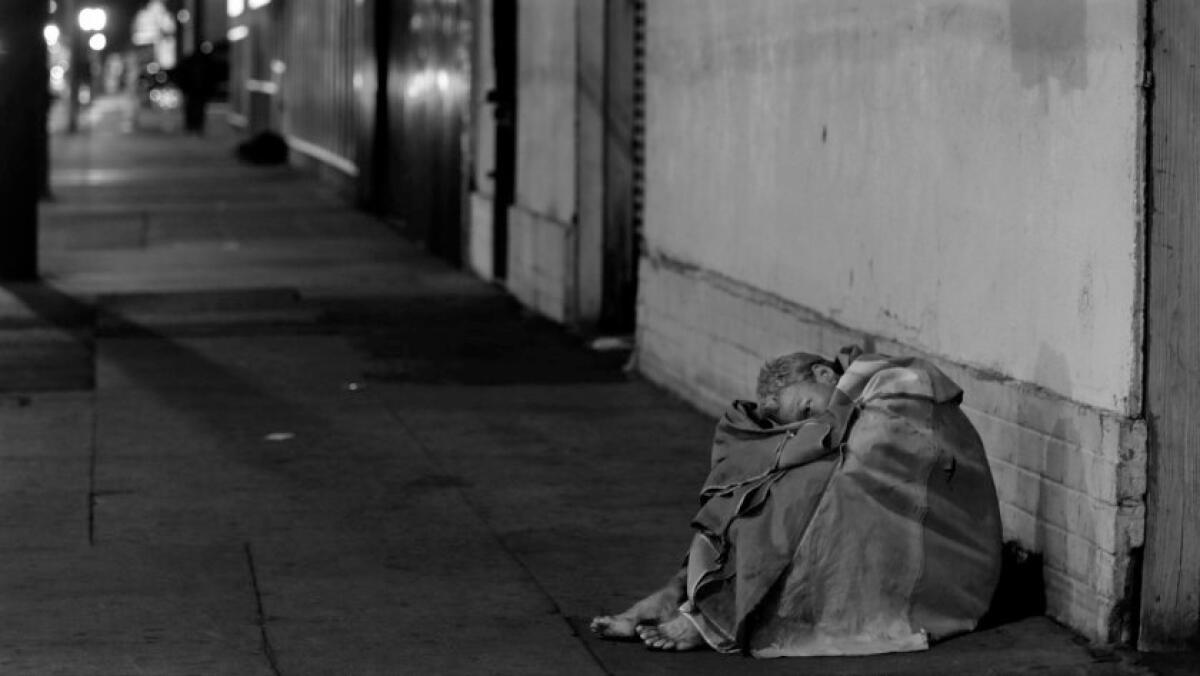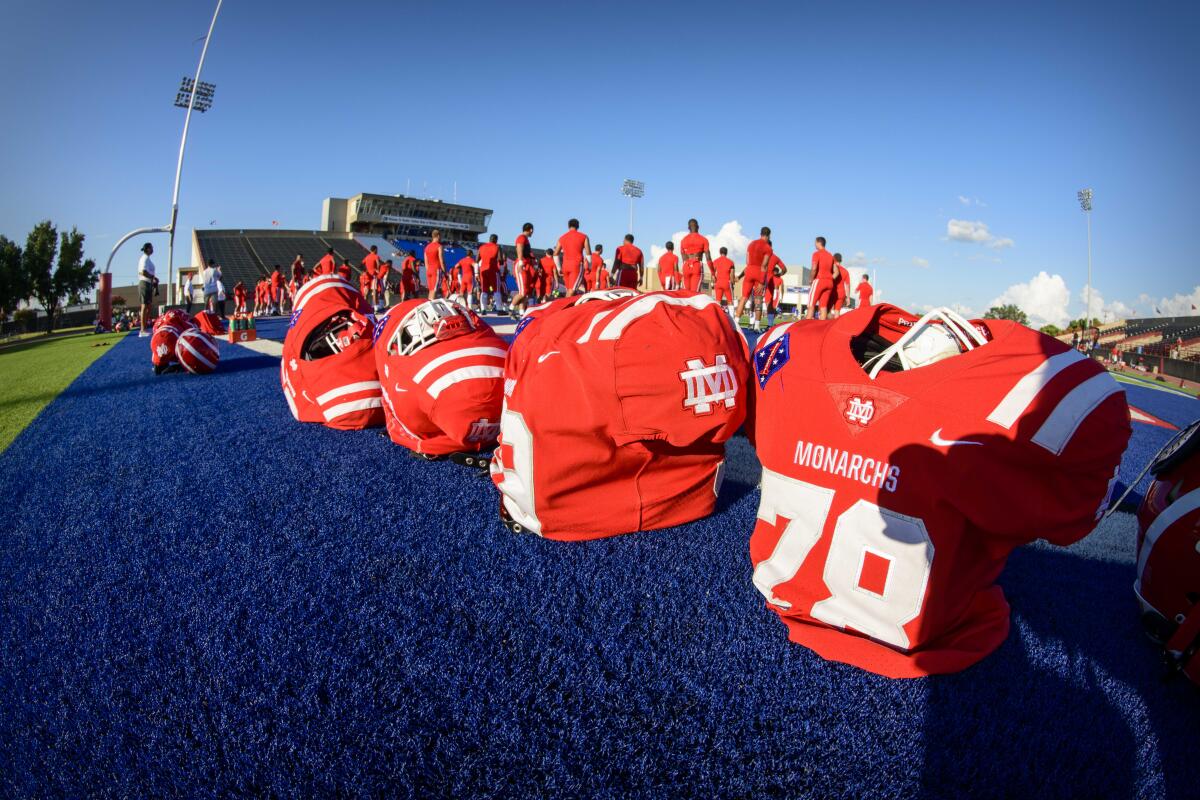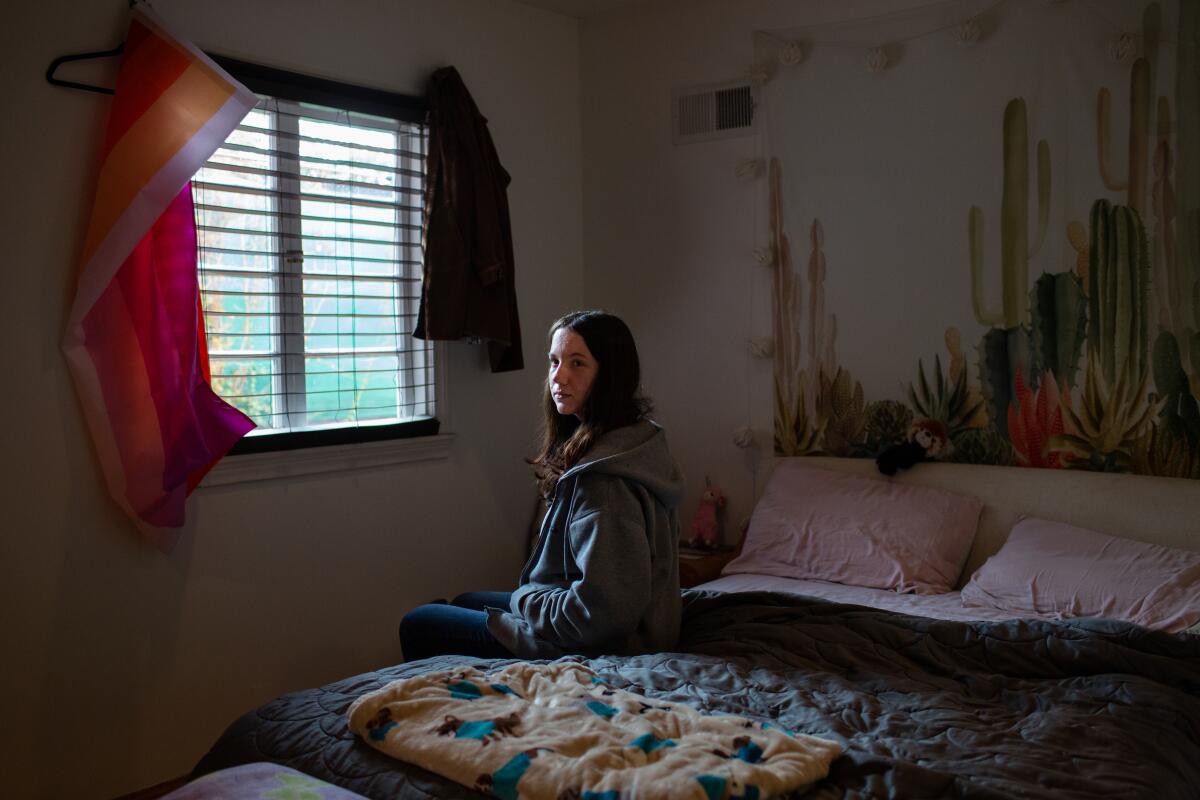‘It must be saving lives’: Could a New York law help unhoused people in California?

- Share via
Good morning, and welcome to the Essential California newsletter. It’s Monday, Dec. 6. I’m Justin Ray.
I have a confession to make.
All newsletters I sent last week were composed in New York City, either in a hotel near Times Square or at my buddy’s place in Jackson Heights, Queens.
I lived in the city for seven years before I moved to Los Angeles. During my trip last week, I had many fun moments, like enjoying drinks at the Monster, a piano bar in the West Village, and listening to Jeff Buckley’s haunting cover of “Hallelujah” in Times Square. Unfortunately I didn’t get to enjoy a shawarma at Mamoun’s on MacDougal Street.
Something that stood out to me during my visit was the fact that I saw no tents during my entire stay.
The issue of homelessness is a complicated, controversial onein California. There have been many solutions proposed: tiny houses and converted shipping containers; city-sanctioned tent encampments; or increasing collaboration among local leaders.
One solution sometimes discussed is replicating New York’s “right to shelter” law, which requires New York to provide a place for unhoused people. The law was established 40 years ago.
I want to tell you the story behind the law, because it’s riveting. Then, I wanted to talk about how feasible it would be for California to adopt a similar mandate.
Callahan vs. Carey
Robert Hayes was a 26-year-old lawyer who worked for a Wall Street firm, the New Yorker explains. He witnessed many people living on the streets in lower Manhattan and felt the city was neglecting its obligations to its inhabitants. Hayes filed a class-action lawsuit on behalf of three men in October 1979, with the lead plaintiff, Robert Callahan, an unhoused man suffering from alcoholism. Hayes worked the case pro bono.
It was a true David and Goliath situation: A young guy was taking on the city and state in an unlikely bid to fundamentally change how New York provides for unhoused people.
As you have probably guessed, the unexpected happened. On Dec. 5, 1979, a New York State Supreme Court justice issued a ruling in favor of the plaintiffs.
“Attorneys for the state and the city were stunned,” according to the New Yorker. “Soon, more than a thousand men were seeking shelter every night, and the city had to scramble to keep up.”
The case, Callahan vs. Carey (Hugh L. Carey was the governor at the time) established New York state’s obligation to house homeless men in 1981 (in 1982, the right was extended to women with Eldredge vs. Koch).
However, the ruling didn’t help Callahan himself; the autumn before the consent decree that carried his name was signed, Callahan was found dead of alcoholism while sleeping on the streets of Manhattan’s Lower East Side. He was one of the last homeless people to die in the city before the right to shelter was put in place.
The right to shelter in New York and California
James Winans, who serves as the CEO of the Bowery Mission, one of New York City’s oldest and best-known organizations offering aid to unhoused people, told The Times that most people without a home are able to stay indoors overnight due to the law. While the solution is not perfect, shelters are vital in a city where people face the heat of summerand the cold of winter.
“Having tens of thousands of people in shelters is not ideal, but it must be saving lives,” Winans says. He adds that these facilities help keep people safe in other ways. Although assaults and drug use can certainly happen in shelters, “it’s much less likely to happen in a controlled environment than it is on the streets.”
In the past, it has been noted that unhoused people in Los Angeles may suffer from the cold more than the community in New York City. That’s the consequence of more of them living outdoors, despite L.A. having a warmer climate.
In California, establishing a right to shelter law would be difficult. As my colleague Benjamin Oreskes has reported, “large amounts of capital would need to be appropriated from the state budget to execute a plan like this.” Residents in areas where state environmental laws have been used to file lawsuits that end up blocking shelters would need to be placated.
And now, here’s what’s happening across California:
Note: Some of the sites we link to may limit the number of stories you can access without subscribing.
‘They do stuff to them ... pour urine in a kid’s locker’: The parents of an ex-Mater Dei football player at the center of a lawsuit against the school and the Diocese of Orange gave new details about the fight that the suit says left him with a traumatic brain injury. The 170-pound football player told his parents the fear of retribution prompted him to agree to fight a more experienced 235-pound teammate in the middle of a Mater Dei locker room. His father talked angrily about being ignored or dismissed by Mater Dei officials during his quest for transparency and accountability. His mother talked mournfully about feeling abandoned by the self-proclaimed “community built on Catholic fellowship.” Los Angeles Times

L.A. STORIES
After two years of rising violent crime in Los Angeles, recent incidents have sparked a national conversation and led to local concern about the crimes themselves and where the outrage over the violence will lead. While overall city crime rates remain far below records set during the notorious gang wars of the 1990s, violent crime has jumped sharply in L.A., as it has in other cities. Much of the violence has occurred in poor communities and among vulnerable populations, such as homeless people. However, since the start of the pandemic and more rapidly in recent months, crime has crept up in wealthier enclaves and thrust its way to the center of public discourse in L.A. Los Angeles Times
Our daily news podcast
If you’re a fan of this newsletter, you’ll love our daily podcast “The Times,” hosted every weekday by columnist Gustavo Arellano, along with reporters from across our newsroom. Go beyond the headlines. Download and listen on our App, subscribe on Apple Podcasts and follow on Spotify.
POLITICS AND GOVERNMENT
Six decades after California transportation officials began seizing hundreds of properties for a freeway project that never came, Los Angeles leaders have unveiled a proposal to replace the decaying vacant homes and dirt-filled lots in an El Sereno neighborhood with new parks and housing. If the plan comes to fruition, it would be a major step forward in the saga involving the curtailed 710 Freeway, which hit a wall of opposition before it could stretch into wealthier communities. The Eastside neighborhood has long borne the most visible and lasting scars of the abandoned project, with a high concentration of derelict homes left in its wake. As the COVID-19 pandemic hit, activists repeatedly tried to take over vacant homes in a reaction to the region’s affordable housing crisis. Los Angeles Times
CRIME AND COURTS
After Jacqueline Avant was killed, a teen found the suspected gunman in her backyard. Grace Campbell-McGuire was in bed about 3 a.m. Wednesday, awakened by what she thought was her father rummaging through a drawer outside her room. The 17-year-old was annoyed because she had to get up in a few hours for school. Then came a loud bang, followed by the voice of a man she didn’t know crying out in pain. Grace braced herself against her door and called 911 to report the intruder. A few minutes later, she heard the man’s voice calling 911 himself. Los Angeles Times

Two Long Beach police officers are facing felony charges after an investigation into an allegedly falsified police report. David Mariano Salcedo, 28, and Dedier Reyes, 38, each faces one count of filing a false police report and one count of filing a false government document, according to the Long Beach Police Department. Reyes also faces one count of perjury. Police did not elaborate on what the discrepancies were, and an agency representative could not be reached Friday night for clarification. Los Angeles Times
Support our journalism
HEALTH AND THE ENVIRONMENT
State laws have held people liable for damages if they started a fire that burned out of control. But a new California law will remove the liability risk for private citizens and Indigenous people who set controlled burns, which are low-intensity and can prevent catastrophic blazes. The law comes into effect Jan. 1. “[The law] recognizes the value of this Indigenous knowledge and this experience of Native people with fire, so much so that they have said that we are on par with California-certified burn bosses,” said Margo Robbins, a member of the Yurok tribe in Northern California and executive director of the Cultural Fire Management Council. Al Jazeera
Central Valley coalition sues the EPA over clean air failures. The Central Valley has the worst air quality in the nation in terms of exposure to fine particulate matter. Environmental justice groups in the area are fighting back against the smog; in November, a coalition of advocacy organizations filed a lawsuit against the EPA in federal court for failing to intervene in the region’s air quality crisis. “The San Joaquin Valley is a sacrifice zone. We get all of the bad, all of the unwanted land uses. We get the waste, we get the pollution. We’re the dumping ground,” said Dr. Catherine Garoupa White, executive director, Central Valley Air Quality Coalition. Capital and Main
CALIFORNIA CULTURE
Catching up with Stephen Glass. Journalism has had many scandals that call into question a reporter’s integrity. Stephen Glass perpetrated what is perhaps the most extensive, known fraud in American journalism. As a staff writer at the New Republic in the 1990s, he made up quotes and characters. He even fabricated notes and a website to fortify his lies. He now works as a non-lawyer at a personal-injury law firm in Los Angeles. This deep dive explains how Glass has tried to make amends with those he has hurt. It also explains that he’s now adamant about telling the truth in life — which was hard when his wife asked him to lie about her Alzheimer’s as a form of “therapeutic fibbing.” Airmail
A survivor of domestic violence was expected to be released this past Sunday after more than 11 years in prison. But advocates say California officials turned her over early to immigration agents. Marisela Andrade was supposed to leave Central California Women’s Facility in Chowchilla and was set to do a reintegration program, advocates told the Fresno Bee. Andrade was imprisoned for her role in the death of her husband. Pamela Fadem, a longtime advocate with the California Coalition for Women Prisoners, said Andrade has been in the U.S. for more than 20 years, and doesn’t have legal documentation. “That’s one of the reasons why she never reported the abuse,” she said. Dana Simas, press secretary for California Department of Corrections and Rehabilitation, said officials were still looking into Andrade’s case. The American Civil Liberties Union has filed a lawsuit against the Sacramento County Sheriff’s office, alleging that the department has done the same with individuals in the country illegal. Fresno Bee
Free online games
Get our free daily crossword puzzle, sudoku, word search and arcade games in our new game center at latimes.com/games.
CALIFORNIA ALMANAC
Los Angeles: 72 San Diego: 67 San Francisco: Cloudy 62 San Jose: 62 Fresno: 58 Sacramento: Cloudy, 55
AND FINALLY
Famous birthdays
Yasiel Puig was born Dec. 7, 1990. The former Dodger is one of many famous people who have recently been victims of so-called knock-knock burglaries.
Nicki Minaj was born Dec. 8, 1982. The rapper’s Twitter account caused quite a stir this year.
If you have a memory or story about the Golden State, share it with us. (Please keep your story to 100 words.)
Please let us know what we can do to make this newsletter more useful to you. Send comments to [email protected].
Sign up for Essential California
The most important California stories and recommendations in your inbox every morning.
You may occasionally receive promotional content from the Los Angeles Times.




